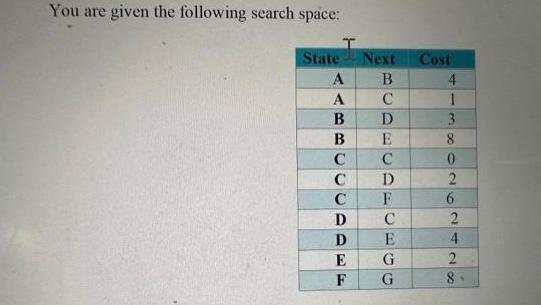Answered step by step
Verified Expert Solution
Question
1 Approved Answer
You are given the following search space: State A A B B C C C D D E F Next B C D E


You are given the following search space: State A A B B C C C D D E F Next B C D E C D F C E G G Cost 4 1 3 8 0 2 6 2428 8. Part A: State Space Visualization a) Create a visual representation of the given state space. Use nodes to represent states (e.g., A, B, C) and edges to indicate possible transitions between states, along with their associated costs. Part B: Search Strategy Comparison Assume that the initial state is A, and the goal state is G. Explore how each search strategy creates a search tree to find a path from the initial state to the goal state. Moreover, shows which node is being expanded and the fringe content for each algorithm step. 1. Breadth-First Search (BFS) II. Depth-First Search (DFS) III. Iterative Deepening Search (IDS) IV. Uniform Cost Search (UCS) Instructions: 1. Draw the state space (Part A) and document the search tree progress for each search strategy (Part B). 2. Use a clear search tree and brief descriptions to illustrate each step of the algorithms. 3. Compare and analyze the differences in search strategies and their efficiency in finding the optimal path from the initial state A to the goal state G. You are given the following search space: State A A B B C C C D D E F Next B C D E C D F C E G G Cost 4 1 3 8 0 2 6 2428 8. Part A: State Space Visualization a) Create a visual representation of the given state space. Use nodes to represent states (e.g., A, B, C) and edges to indicate possible transitions between states, along with their associated costs. Part B: Search Strategy Comparison Assume that the initial state is A, and the goal state is G. Explore how each search strategy creates a search tree to find a path from the initial state to the goal state. Moreover, shows which node is being expanded and the fringe content for each algorithm step. 1. Breadth-First Search (BFS) II. Depth-First Search (DFS) III. Iterative Deepening Search (IDS) IV. Uniform Cost Search (UCS) Instructions: 1. Draw the state space (Part A) and document the search tree progress for each search strategy (Part B). 2. Use a clear search tree and brief descriptions to illustrate each step of the algorithms. 3. Compare and analyze the differences in search strategies and their efficiency in finding the optimal path from the initial state A to the goal state G. You are given the following search space: State A A B B C C C D D E F Next B C D E C D F C E G G Cost 4 1 3 8 0 2 6 2428 8. Part A: State Space Visualization a) Create a visual representation of the given state space. Use nodes to represent states (e.g., A, B, C) and edges to indicate possible transitions between states, along with their associated costs. Part B: Search Strategy Comparison Assume that the initial state is A, and the goal state is G. Explore how each search strategy creates a search tree to find a path from the initial state to the goal state. Moreover, shows which node is being expanded and the fringe content for each algorithm step. 1. Breadth-First Search (BFS) II. Depth-First Search (DFS) III. Iterative Deepening Search (IDS) IV. Uniform Cost Search (UCS) Instructions: 1. Draw the state space (Part A) and document the search tree progress for each search strategy (Part B). 2. Use a clear search tree and brief descriptions to illustrate each step of the algorithms. 3. Compare and analyze the differences in search strategies and their efficiency in finding the optimal path from the initial state A to the goal state G.
Step by Step Solution
There are 3 Steps involved in it
Step: 1

Get Instant Access to Expert-Tailored Solutions
See step-by-step solutions with expert insights and AI powered tools for academic success
Step: 2

Step: 3

Ace Your Homework with AI
Get the answers you need in no time with our AI-driven, step-by-step assistance
Get Started


